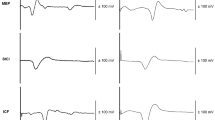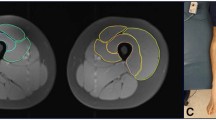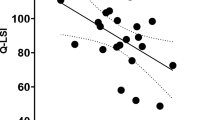Abstract
Decreased voluntary activation contributes to quadriceps weakness following anterior cruciate ligament reconstruction (ACLR). Alterations in neural excitability are likely responsible for reductions in quadriceps voluntary activation, and may be due to specific alterations in intracortical inhibition and facilitation. Therefore, we sought to determine if intracortical inhibition (SICI) and intracortical facilitation (ICF) associate with quadriceps voluntary activation in individuals with ACLR. Twenty-seven participants with a primary, unilateral ACLR were enrolled in this study. Bilateral central activation ratio (CAR) and paired-pulse transcranial magnetic stimulation were used to assess quadriceps voluntary activation, as well as SICI and ICF in the vastus medalis, respectively. Pearson Product Moment correlations were used to determine the association between CAR and (1) SICI, and (2) ICF in each limb. Lesser CAR associated with lesser SICI amplitude (r = 0.502, P = 0.008) in the ACLR limb. No associations in the contralateral limb were significant. Our results suggest greater intracortical inhibition associates with lesser voluntary activation in individuals with ACL. Implementing interventions that target intracortical inhibition may aid in restoring quadriceps voluntary activation following ACLR.


Similar content being viewed by others
References
Ardern CL, Webster KE, Taylor NF, Feller JA (2011) Return to sport following anterior cruciate ligament reconstruction surgery: a systematic review and meta-analysis of the state of play. Br J Sports Med 45:596–606. doi:10.1136/bjsm.2010.076364
Barker AT, Freeston IL, Jalinous R, Jarratt JA (1985) Non-invasive stimulation of motor pathways within the brain using time-varying magnetic-fields. Electroen Clin Neuro 61:S245–S246. doi:10.1016/0013-4694(85)90926-5
Bonfim TRR, Jansen Paccola CA, Barela JAA (2003) Proprioceptive and behavior impairments in individuals with anterior cruciate ligament reconstructed knees. Arch Phys Med Rehab 84:1217–1223. doi:10.1016/S0003-9993(03)00147-3
Briggs KK, Lysholm J, Tegner Y, Rodkey WG, Kocher MS, Steadman JR (2009) The reliability, validity, and responsiveness of the Lysholm score and Tegner activity scale for anterior cruciate ligament injuries of the knee: 25 years later. Am J Sports Med 37:890–897. doi:10.1177/0363546508330143
Cacchio A, cimini N, Alsoi P, Santilli V, Marrelli A (2009) Reliability of transcranial magnetic stimulation-related measurements of tibialis anterior muscle in healthy subjects. Clin Neurophysiol 120:414–419
Caramia MD et al (2004) Brain excitability changes in the relapsing and remitting phases of multiple sclerosis: a study with transcranial magnetic stimulation Clin Neurophysiol Off J Int Fed Clin Neurophysiol 115:956–965. doi:10.1016/j.clinph.2003.11.024
Chen R (2000) Studies of human motor physiology with transcranial magnetic stimulation Muscle Nerve Suppl 9:S26–S32
Chen R, Tam A, Butefisch C, Corwell B, Ziemann U, Rothwell JC, Cohen LG (1998) Intracortical inhibition and facilitation in different representations of the human motor cortex. J Neurophysiol 80:2870–2881
Collins NJ, Misra D, Felson DT, Crossley KM, Roos EM (2011) Measures of knee function: International Knee Documentation Committee (IKDC) Subjective Knee Evaluation Form, Knee Injury and Osteoarthritis Outcome Score (KOOS), Knee Injury and Osteoarthritis Outcome Score Physical Function Short Form (KOOS-PS), Knee Ou Arthritis Care & Research 63. doi:10.1002/acr.20632
Di Lazzaro V et al (2003) Ketamine increases human motor cortex excitability to transcranial magnetic stimulation. J Physiol 547:485–496 doi:10.1113/jphysiol.2002.030486
Faul F, Erdfelder E, Lang AG, Buchner A (2007) G*Power 3: a flexible statistical power analysis program for the social, behavioral, and biomedical sciences. Behav Res Methods 39:175–191
Gandevia SC, Petersen N, Butler JE, Taylor JL (1999) Impaired response of human motoneurones to corticospinal stimulation after voluntary exercise. J Physiol 521:749–759. doi:10.1111/j.1469-7793.1999.00749.x
Giesebrecht S, Martin PG, Gandevia SC, Taylor JL (2010) Facilitation and inhibition of tibialis anterior responses to corticospinal stimulation after maximal voluntary contractions. J Neurophysiol 103:1350–1356 doi:10.1152/jn.00879.2009
Gomez-Barrena E, Martinez-Moreno E, Munuera L (1996) Segmental sensory innervation of the anterior cruciate ligament and the patellar tendon of the cat’s knee. Acta Orthop Scand 67:545–552
Heroux ME, Tremblay F (2006) Corticomotor excitability associated with unilateral knee dysfunction secondary to anterior cruciate ligament injury. Knee Surg Sports Traumatol Arthrosc 14:823–833. doi:10.1007/s00167-006-0063-4
Hopkins JT, Ingersoll CD (2000) Arthrogenic muscle inhibition: a limiting factor in joint rehabilitation. J Sport Rehabil 9:135–159
Kapreli E et al (2009) Anterior cruciate ligament deficiency causes brain plasticity: a functional MRI study. Am J Sports Med 37:2419–2426. doi:10.1177/0363546509343201
Kittelson AJ, Thomas AC, Kluger BM, Stevens-Lapsley JE (2014) Corticospinal and intracortical excitability of the quadriceps in patients with knee osteoarthritis. Exp Brain Res 232:3991–3999. doi:10.1007/s00221-014-4079-6
Lepley LK (2015) Deficits in quadriceps strength and patient-oriented outcomes at return to activity after ACL reconstruction: a review of the current literature. Sports Health 7:231–238 doi:10.1177/1941738115578112
Lepley AS, Ericksen HM, Sohn DH, Pietrosimone BG (2014) Contributions of neural excitability and voluntary activation to quadriceps muscle strength following anterior cruciate ligament reconstruction. Knee 21:736–742. doi:10.1016/j.knee.2014.02.008
Lepley AS, Gribble PA, Thomas AC, Tevald MA, Sohn DH, Pietrosimone BG (2015) Quadriceps neural alterations in anterior cruciate ligament reconstructed patients: A 6-month longitudinal investigation. Scand J Med Sci Sports 25:828–839 doi:10.1111/sms.12435
Lewek M, Rudolph K, Axe M, Snyder-Mackler L (2002) The effect of insufficient quadriceps strength on gait after anterior cruciate ligament reconstruction. Clin Biomech (Bristol Avon) 17:56–63 pii]
Luc BA, Lepley AS, Tevald MA, Gribble PA, White DB, Pietrosimone BG (2013) Reliability of corticomotor excitability in leg and thigh musculature at 14 and 28 days. J Sport Rehabil. doi:10.1123/jsr.2013-0069
Luc BA, Harkey MH, Arguelles GD, Blackburn JT, Ryan ED, Pietrosimone B (2016) Measuring voluntary quadriceps activation: effect of visual feedback and stimulus delivery. J Electromyogr Kinesiol Off J Int Soc Electrophysiol Kinesiol 26:73–81. doi:10.1016/j.jelekin.2015.10.006
Mikesky AE, Meyer A, Thompson KL (2000) Relationship between quadriceps strength and rate of loading during gait in women. J Orthop Res Off Publ Orthop Res Soc 18:171–175. doi:10.1002/jor.1100180202
Mukaka MM (2012) Statistics corner: a guide to appropriate use of correlation coefficient in medical research. Malawi Med J J Med Assoc Malawi 24:69–71
Nitsche MA, Paulus W (2000) Excitability changes induced in the human motor cortex by weak transcranial direct current stimulation. J Physiol 527 Pt 3:633–639 doi:10.1111/j.1469-7793.2000.t01-1-00633.x
O’Leary TJ, Morris MG, Collett J, Howells K (2015) Reliability of single and paired-pulse transcranial magnetic stimulation in the vastus lateralis muscle. Muscle Nerve 52:605–615. doi:10.1002/mus.24584
Otzel DM, Chow JW, Tillman MD (2015) Long-term deficits in quadriceps strength and activation following anterior cruciate ligament reconstruction. Phys Therapy Sport Off J Assoc Chart Physiother Sports Med 16:22–28. doi:10.1016/j.ptsp.2014.02.003
Petersen N, Butler JE, Taylor JL, Gandevia SC (2010) Probing the corticospinal link between the motor cortex and motoneurones: some neglected aspects of human motor cortical function. Acta Physiologica 198:403–416 doi:10.1111/j.1748-1716.2009.02066.x
Pietrosimone BG, Saliba SA (2012) Changes in voluntary quadriceps activation predict changes in quadriceps strength after therapeutic exercise in patients with knee osteoarthritis. Knee 19:939–943. doi:10.1016/j.knee.2012.03.002
Pietrosimone B, Lepley AS, Murray AM, Thomas AC, Bahhur NO, Schwartz TA (2014) Changes in voluntary quadriceps activation predict changes in muscle strength and gait biomechanics following knee joint effusion Clin Biomech, 29. Avon, (Bristol, pp 923–929. doi:10.1016/j.clinbiomech.2014.06.014
Pietrosimone B, McLeod MM, Florea D, Gribble PA, Tevald MA (2015a) Immediate increases in quadriceps corticomotor excitability during an electromyography biofeedback intervention. J Electromyogr Kinesiol Off J Int Soc Electrophysiol Kinesiol 25:316–322. doi:10.1016/j.jelekin.2014.11.007
Pietrosimone BG, Lepley AS, Ericksen HM, Clements A, Sohn DH, Gribble PA (2015b) Neural excitability alterations after anterior cruciate ligament reconstruction. J Athletic Train 50:665–674 doi:10.4085/1062-6050-50.1.11
Pietrosimone B et al. (2016) Quadriceps Strength Predicts Self-reported Function Post ACL Reconstruction Med Sci Sport Exer doi:10.1249/MSS.0000000000000946
Reis J et al (2008) Contribution of transcranial magnetic stimulation to the understanding of cortical mechanisms involved in motor control. J Physiol 586:325–351. doi:10.1113/jphysiol.2007.144824
Rice DA, McNair PJ, Lewis GN, Dalbeth N (2014) Quadriceps arthrogenic muscle inhibition: the effects of experimental knee joint effusion on motor cortex excitability. Arthritis Res Ther 16:502. doi:10.1186/s13075-014-0502-4
Rice DA, Graven-Nielsen T, Lewis GN, McNair PJ, Dalbeth N (2015) The effects of experimental knee pain on lower limb corticospinal and motor cortex excitability. Arthritis Res Ther 17:204. doi:10.1186/s13075-015-0724-0
Roberts D, Kuenze C, Saliba S, Hart JM (2012) Accessory muscle activation during the superimposed burst technique. J Electromyogr Kinesiol Off J Int Soc Electrophysiol Kinesiol 22:540–545. doi:10.1016/j.jelekin.2012.01.008
Rossini PM, Rossini L, Ferreri F (2010) Brain–behavior relations: transcranial magnetic stimulation: a review. IEEE Eng Med Biol Mag 29:84–95. doi:10.1109/MEMB.2009.935474
Stevens-Lapsley JE, Thomas AC, Hedgecock JB, Kluger BM (2013) Corticospinal and intracortical excitability of the quadriceps in active older and younger healthy adults. Arch Gerontol Geriatr 56:279–284. doi:10.1016/j.archger.2012.06.017
Tourville TW, Jarrell KM, Naud S, Slauterbeck JR, Johnson RJ, Beynnon BD (2014) Relationship between isokinetic strength and tibiofemoral joint space width changes after anterior cruciate ligament reconstruction. Am J Sports Med 42:302–311. doi:10.1177/0363546513510672
Ward SH, Pearce A, Bennell KL, Peitrosimone B, Bryant AL (2016) Quadriceps cortical adaptations in individuals with an anterior cruciate ligament injury. Knee 23:582–587. doi:10.1016/j.knee.2016.04.001
Author information
Authors and Affiliations
Corresponding author
Rights and permissions
About this article
Cite this article
Luc-Harkey, B.A., Harkey, M.S., Pamukoff, D.N. et al. Greater intracortical inhibition associates with lower quadriceps voluntary activation in individuals with ACL reconstruction. Exp Brain Res 235, 1129–1137 (2017). https://doi.org/10.1007/s00221-017-4877-8
Received:
Accepted:
Published:
Issue Date:
DOI: https://doi.org/10.1007/s00221-017-4877-8




